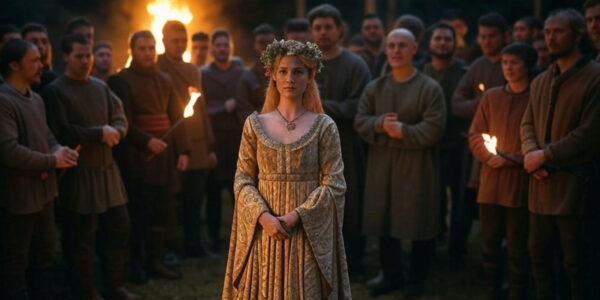The Horniest Harvest Party in History
Picture this – a ragtag medieval village, the chill of a long winter finally thawing out, and a blazing bonfire lighting up the night. At the center of it all is a young woman crowned with wildflowers, surrounded by men whose wide-eyed anticipation is impossible to miss. Is this a sacred rite to appease the earth…or the medieval world’s most epic guys’ night out?
You decide, but here’s our pitch: these Pagan Spring Festivals might just be medieval Europe’s rowdiest secret—a combo of fertility ceremony and full-on gangbang, disguised by time and hush-hush records. Sure, we can’t say for certain that’s how it went down, but we can’t resist the possibility. Let’s just say if these festivals were about ensuring abundant crops, the men definitely got a sweet reward in the process.
So buckle up, history buffs (and horny festival enthusiasts): we’re about to blow the dust off medieval texts, speculate wildly, and celebrate the cultural secrets that might’ve made springtime in the Dark Ages a whole lot warmer than you’d think.
The Medieval Scene: A World Ready to Party
Fast-forward (or rather, rewind) to post-Roman Europe. The mighty empire’s influence had collapsed, leaving behind a patchwork of tribal customs, half-baked Christian conversions, and a deep-rooted pagan heritage that refused to quit. Spring wasn’t just about flowers blooming; it was survival on the line. Harvests mattered—big time. A crap harvest meant empty bellies and brutal winters. So when spring came knocking, it wasn’t just an excuse for a picnic. It was a do-or-die celebration.
Into this fertile chaos stepped festivals like Beltane (Celtic) and the early precursors to May Day. Sure, the Church tried to tone things down, or at least cloak them in saintly veneer, but the old ways persisted. Those bonfires you’ve read about? They weren’t just for show. People believed these flames guarded against evil spirits and jump-started the land’s fertility. Animals were herded between twin bonfires, couples danced around Maypoles, and the entire village threw itself into the kind of blowout that would make your modern rave look like a tea party.
Why so wild? Think about it: you’ve just endured a winter of scarce food and bone-chilling nights. You’re tired, hungry, and let’s be honest, more than a little pent-up. When the snows finally melt, you celebrate with everything you’ve got. And if the old gods liked a little action to bless the fields, who were you to argue?
Enter the May Queen: Medieval MVP
At the heart of these pagan parties stood one figure who embodied the earth’s renewed fertility: the May Queen. Adorned with fresh flowers, she symbolized the goddess of spring, an avatar of the land’s abundance. According to custom, she’d be chosen from among the village’s most vibrant maidens—someone who radiated that youthful glow that farmers hoped to see mirrored in their crops.
But here’s where our speculation rears its tantalizing head. We’re not just talking about a bit of crowning and parading through the village. What if the May Queen was also the night’s grand prize? All that attention, those longing glances—maybe it wasn’t purely symbolic. What if behind the ritual songs and flower garlands, there was a promise that she was the reward for the men who kept the village afloat through the harsh cold?
Let’s not kid ourselves: medieval times could be rough, and not everyone walked around with modern concepts of courtesy and consent. But let’s try to believe, for the sake of our naughty daydream, that the May Queen was both revered and enthusiastically receptive to being the central figure in the wildest village after-party. Revered goddess by day, ravished royalty by night. Hey, it’s a festival—what happens in the spring fields, stays in the spring fields…or so we imagine.

The Main Event: A Gangbang for the Ages
So, how might the big moment have played out? Picture this: The bonfire blazing, men forming a circle around the May Queen, chanting or singing (we can’t be sure; we weren’t there, but we’ll throw in some drums for drama). As they close in, one by one, they participate in what might be described as a “communal blessing”—but let’s call a spade a spade: it sounds a heck of a lot like a gangbang in the making.
Warriors, farmers, blacksmiths, maybe even that awkward lute player from the tavern—everyone gets a turn because, presumably, their efforts kept the village going all year. Some suggest that in certain rites, only the bravest hunters or toughest warriors got the first go, a carnal pat on the back for putting food on tables. Others imagine it might have been a free-for-all, chaotic but sanctioned by tradition. Is there solid, footnoted evidence for this? Not exactly. But you can find hints in the pages of Bede’s Ecclesiastical History—accounts of rowdy spring revelries, offerings to old gods, and customs so scandalous that Christian chroniclers either refused to detail them or blasted them as demon-worship.
Fertility? Absolutely. But consider the possibility that it was also about giving the guys a well-deserved party. In a world where life was short and dominated by war, famine, and disease, a festival that celebrated virility and rewarded male heroics with, well, an orgiastic bonus might’ve made perfect cultural sense.
Why It Worked: Rewarding the Boys, Saving the Village
Let’s break down the logic. Medieval village life was precarious. You needed strong men to hunt, fight off rival clans, and ensure everyone survived the winter. Morale had to be kept high, or risk losing your best defenders to wanderlust or rival territories. Offering them a chance at a once-a-year, no-holds-barred sexual blowout could be seen as the ultimate thanks for a job well done. It wasn’t just a “horny free-for-all”—it was smart social glue.
Speculative scenarios abound: maybe the local chief or elder used these rites to ensure loyalty. Perhaps each man drew lots (imagine medieval lottery tickets) to see if he’d score a turn with the May Queen. Or maybe everyone just piled in at once in a swirl of half-drunken euphoria, with the entire spectacle believed to bless the fields—and the future children, ironically, might also end up being the next generation of laborers and defenders.
This is where the word “gangbang” really sticks its neck out: one woman, multiple men. And it’s not a 21st-century porn trope but a structured, socially significant phenomenon (or so we’re hypothesizing). The concept is deeply primal—ensuring as many potential fathers as possible, hedging bets on fertility, or simply letting the men run wild with the village’s symbolic goddess. For a medieval community, it might’ve been the mother of all morale boosters.
The Church Crashes the Party: Decline and Denial
Of course, nothing this juicy could stay secret forever—especially once the Christian Church started tightening its grip on Europe. Missionaries and monks fanned out across the continent, hacking down sacred groves and condemning pagan revelries as devil-worship. Saints like Boniface were notorious for leveling ancient oaks and building churches on the same spots, effectively rebranding old pagan stomping grounds.
Any blatant display of group sex for a fertility rite was bound to get hammered. Historical records (or lack thereof) bear out the Church’s success in **stamping out—or covering up—**these rituals. If there were explicit references to a local May Queen servicing the whole village, you can bet monastic scribes either left them out or cleaned them up to avoid scandal. As the year 1000 approached, many older traditions were diluted, disguised, or outright banned.
Still, traces linger in folklore. Think of Robin Hood tales that revolve around May Day merrymaking, or allegations about witches’ sabbaths with their infernal orgies. Even centuries later, we see hints of Europe’s earlier, rowdier era. Where there’s smoke, there’s fire—and where there’s mention of “sinful frolics,” there might well have been a very enthusiastic festival that once included a central lady and a line of anxious men.
Conclusion: Medieval Gangbangs—Fact, Fantasy, or Both?
So, what do we have here? A half-forgotten fertility rite, or the ultimate “bro treat” cleverly disguised as a religious ceremony? Maybe both. Perhaps these Pagan Spring Festivals were indeed about ensuring the land’s bounty through symbolic acts. But maybe—just maybe—they included an extra perk for the men whose sweat and swords kept the village afloat all year. A bit of holy, a bit of horny, and a whole lot of mesmerizing speculation.
We can’t say for certain if the May Queen truly found herself in the middle of a circle of lusty villagers, offering her blessings (and more) to each. But the idea stands: in a time when survival was on a knife’s edge, any tradition that rewarded men and glorified fertility could easily take on a decidedly raunchy edge.
What’s your take? Was it ritual, reward, or a medieval mash-up of both? If you ask us, we’ll be in the corner chanting, “Why not both?” after a few rounds of mead. But we want to hear your theories—so spread the word about history’s wildest spring fling, and let your friends weigh in on this mystery-turned-tantalizing gossip. After all, if even a fraction of this is true, your next spring barbecue has some serious competition in the annals of “best party ever.”
Share away: Because who doesn’t love a good medieval mystery with a scandalous secret at its core? Let’s face it, we all like a bit of spice with our history—especially when it’s about a festival that might’ve made Coachella look like Sunday school.
Cheers to the May Queen and the men who lined up to worship her—whether it was an actual rite or just a guilty daydream. Either way, it’s a story we’ll never read in a school textbook, but one we can’t help but wonder about every time spring rolls around again.






